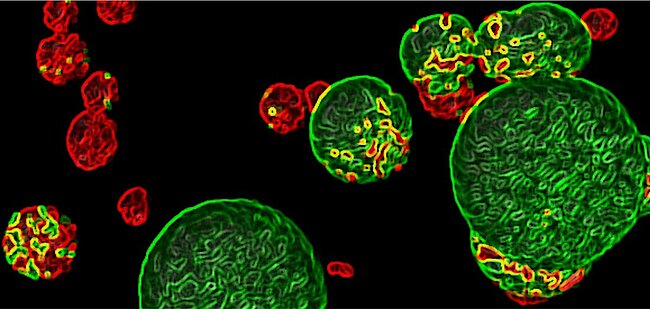
Just over a year ago, in February 2020, 100 experts met in Saarbrücken to shed light on the still young field of research from a wide variety of perspectives. The conference was the starting signal for a lively exchange within the new scientific community, and the wish for a repetition in the near future was already widely expressed on site. Admittedly, the Corona pandemic changed the general conditions and another meeting in Saarland became a distant prospect. But thanks to the possibilities now offered by the virtual world, more than 300 scientists accepted the organizers’ invitation to a second conference.
What are living materials? They consist of two components: living organisms such as yeasts or bacteria, which are intended to perform a specific function and are programmed accordingly, and a carrier material in which the living organisms are encased. The organisms have special metabolic properties and can produce a wide variety of substances, from inorganic salts to metal oxides and biopolymers to highly effective medical agents. This ability can be used to produce engineering and medical materials with novel functions that non-living materials do not possess. These include, for example, self-regeneration of the material after damage, flexible adaptation to environmental stimuli, or extreme longevity.
Living materials can be designed for a variety of applications. It is therefore not surprising that the conference speakers belong to a wide variety of scientific disciplines: They range from medicine, synthetic biology, biotechnology and materials science to cybergenetics, computer science and materials design. “Especially in the field of living materials, it is important that researchers from different disciplines come together,” says Prof. Wilfried Weber, University of Freiburg, as one of the conference organizers. “This field thrives on innovatively combining the latest developments from materials science and biology. At the same time, however, requirements with regard to the safety and sustainability of the new materials must find their way in.” The European Innovation Council is also represented, as living materials have just been classified as an “innovation technology” by the EU.
Professor Aránzazu del Campo, spokesperson of the Leibniz ScienceCampus and Scientific Director at INM – Leibniz Institute for New Materials, also attaches importance to giving young scientists a chance to have their say: “Young, innovative research needs young, motivated people. Therefore it is important to us that scientists who are still at the beginning of their careers are able to present their work. In this way, we rejuvenate and broaden the community and initiate exchange between generations of researchers.”.
Dr. Shrikrishnan Sankaran, coordinator of the Leibniz ScienceCampus and a scientist at INM, sees great potential for the future: “So far, we have only scratched the surface of what else is possible with living materials. Although the research field is developing very quickly, we are still at the beginning, both in basic research and in applications. There is an exciting development ahead for living materials, and our conference will certainly make a major contribution to it.”
(Source: Leibniz INM)
![[Translate to English:]](/fileadmin/_processed_/f/0/csm_logodgm-4_b2722eeace.png)
![[Translate to English:]](/fileadmin/user_upload/logodgm-4.png)